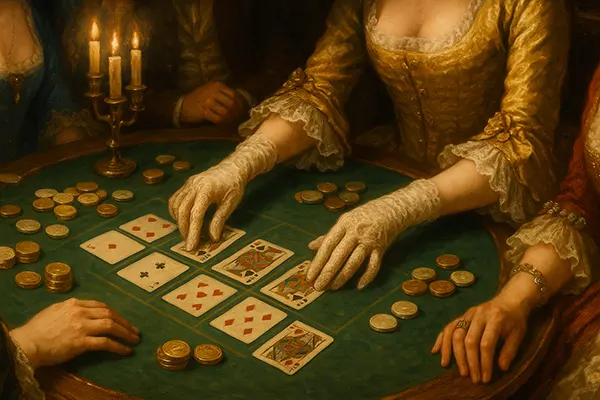
The Faro Ladies: Aristocratic Gamblers of the 18th Century
In the vibrant social circles of 18th-century Europe, few phenomena captured attention as much as the rise of the so-called “Faro Ladies.” These were noblewomen who not only attended salons and masquerade balls but also became deeply involved in the card game Faro, a popular form of entertainment among the elite. Their presence at the gaming table was not just a pastime; it challenged conventions, raised debates on morality, and reshaped the role of women within aristocratic society.
Faro as the Game of Choice Among Aristocrats
Faro originated in France but spread quickly across Europe, reaching England and other courts where it was considered fashionable. The game was relatively simple, relying on luck and quick play, which made it appealing for social gatherings. Unlike games that demanded complex strategies, Faro was accessible, inclusive, and created a charged atmosphere of risk and excitement.
The allure of Faro among the nobility lay not only in the thrill of winning or losing but also in the status it conferred. To host a Faro party was to demonstrate one’s wealth, connections, and ability to entertain. The gaming tables often became the centrepieces of aristocratic salons, where reputations could be built or destroyed overnight.
Women of high birth began to see Faro as a space where they could exercise influence. By hosting games in their salons, they gained social power, expanded their networks, and displayed a boldness that went against the expected passivity of female roles at the time.
The Rise of the Faro Ladies
Female gamblers, often referred to as Faro Ladies, were not anonymous figures but prominent personalities in European courts. Many were duchesses, countesses, or members of royal families who openly played or even banked Faro games. Their involvement gave a sense of legitimacy and glamour to the pastime, encouraging wider participation from both men and women.
These women became both admired and criticised. Admirers saw them as symbols of sophistication and independence, while critics regarded their gambling as dangerous extravagance. The very term “Faro Lady” carried dual meaning: both an acknowledgment of social daring and a subtle rebuke of perceived impropriety.
The prominence of such figures demonstrated how aristocratic women could leverage leisure activities to carve out influence, even in societies that restricted their roles in politics or finance.
Social Implications of Female Gambling
The presence of women at Faro tables signified more than entertainment; it reflected changing dynamics in gender roles. While men had long been associated with risk-taking and financial speculation, the entry of women into gambling blurred those distinctions. The salon became a stage where women could exert authority, command attention, and even rival men in games of chance.
For many aristocratic women, Faro offered a controlled form of rebellion. By managing gaming sessions, they could control the flow of money, dictate social hierarchies within their gatherings, and assert a kind of economic agency otherwise denied to them. Although gambling could ruin fortunes, it also provided opportunities for women to demonstrate wit, resilience, and influence.
The criticism of Faro Ladies was often rooted in broader anxieties about women’s independence. Religious leaders and moralists accused them of undermining the values of family and virtue, yet their popularity at gaming tables continued to grow. This tension highlighted how gambling mirrored larger debates on women’s place in society.
Reactions from Society and the Press
Contemporary newspapers and satirical prints frequently depicted Faro Ladies, sometimes glamorising them, other times ridiculing them. Satirical artists exaggerated their extravagance, portraying them as reckless spenders who endangered family estates. These portrayals reflected both fascination and fear: society was intrigued by powerful women but wary of the disruption they represented.
Some monarchs even issued edicts against excessive gambling, targeting Faro tables as corrupting influences. Despite such measures, enforcement was uneven, and the allure of Faro remained irresistible for many within elite circles. Aristocratic women often circumvented restrictions by hosting private games in their residences.
While the criticism was harsh, the repeated attention in the press ensured that Faro Ladies remained cultural icons. Their images circulated widely, embedding them in the collective memory of 18th-century European society.

Legacy of the Faro Ladies
Although Faro gradually declined in popularity during the 19th century, replaced by other card games and new social pursuits, the legacy of Faro Ladies endured. They had challenged expectations, brought visibility to female agency, and created a cultural archetype that persisted in literature and art. The fascination with their defiance and charisma ensured their place in history.
Writers and historians often returned to the stories of these aristocratic gamblers, noting how they embodied the contradictions of their age: elegance mixed with risk, social duty intertwined with personal pleasure. Their example became part of broader discussions on women’s autonomy and the boundaries of acceptable behaviour in elite society.
Today, Faro Ladies are remembered less for the specifics of their wagers and more for the symbolic role they played in challenging gender conventions. They remain a reminder of how leisure activities can hold deep social and cultural significance.
The Enduring Cultural Impact
Modern portrayals of historical Faro Ladies continue to appear in novels, academic studies, and exhibitions. Their stories provide insight into the interplay between gambling, gender, and power, offering valuable perspectives on the evolution of European aristocracy. They exemplify how seemingly frivolous activities can hold profound cultural weight.
Beyond the tables, their presence influenced fashion, language, and even the moral debates of their era. They showed that the gaming table could serve as both a social hub and a battleground for authority and influence. In this sense, Faro Ladies left an imprint that extends beyond their time.
By studying their lives, historians gain a richer understanding of 18th-century society, where risk, spectacle, and identity intersected. The Faro Ladies thus remain enduring figures in the history of gambling and aristocratic culture.
